Authenticating using your Android (VPN) (legacy)
You can authenticate to your VPN with your Android device in a variety of ways.
Use any of the following options:
|
The options available to you are defined by your organization’s policy. |
If your organization allows you to authenticate using more than one device type, you can also add a device and decide which device you want to use as your primary (default) authentication method. For more information, see Managing your devices.
Using swipe authentication for Android (VPN)
If you have the PingID app running on your mobile device and fingerprint authentication is not enabled, swipe to authenticate for your Android device.
About this task
|
The authentication process might vary slightly depending on the Android version and the notification settings on your device. Some Android versions give you the option to approve the push notification from the lock screen. |
Steps
-
From your web browser or application, sign on to your VPN:
-
Enter your username and password.
If you have more than one device paired with your account, a message appears, displaying a list of all your currently paired devices.
-
For multiple devices only: enter the number of the device you want to use to authenticate.
-
Click Sign In.
Result:
An authentication notification is sent to your device.
-
-
On your device, either:
-
If a PingID notification is shown, approve the notification.
-
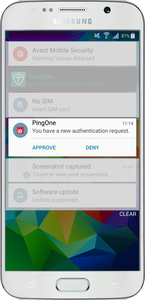
-
If the PingID mobile app opens, swipe up when prompted to do so.
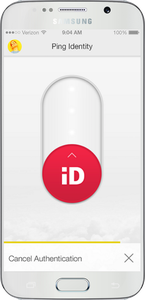
-
For Android version 10 and earlier, you must unlock your device to authenticate.
-
When opening PingID mobile app, update your location permissions to Allow all the time, if prompted to do so.
Result:
A green Authenticated message with a check mark appears, indicating successful authentication and PingID closes. You are automatically signed on to your VPN.
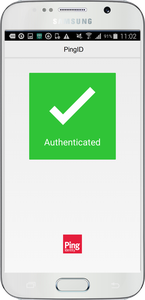
-
Using biometrics authentication for Android (VPN)
Biometrics authentication is simple using a mobile device. Authentication varies slightly depending on your settings and whether your device is locked or unlocked when the authentication request sends.
Before you begin
-
Register your biometrics on your device.
-
Set up your mobile device for VPN authentication. See (legacy) Pairing PingID mobile app for authenticating to your company’s VPN.
About this task
|
Biometrics authentication is only available if your organization enables the option. The authentication process might vary slightly depending on the Android version and the notification settings on your device. The images shown here relate to a Samsung device. Actual implementation might vary according to device model. |
Steps
-
From your web browser or application:
-
Sign on to your VPN with your username and password.
-
Click Sign In.
Result:
If you have more than one device and your organization policy allows it, a message appears showing all of your devices in a numbered list.
-
For multiple devices only: enter the number of the device you want to use to authenticate and click Sign In.
Result:
A message displays requesting that you authenticate, and an authentication notification is sent to your device.
-
-
On your device, if a PingID notification is shown, approve the notification.
-
For Android version 10 and earlier, you must unlock your device to authenticate.
-
When opening PingID mobile app, update your location permissions to Allow all the time, if prompted to do so.
-
-
Scan your biometrics when prompted to do so.
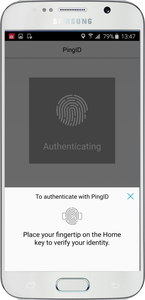
Result
The green Authenticated message appears with a check mark, indicating authentication is successful. You are signed on to your VPN.

Authenticating using a one-time passcode (VPN)
If you do not have internet access temporarily, you can still authenticate using the PingID mobile app by generating a one-time passcode (OTP).
About this task
The OTP is unique and can only be used once. Only the OTP that appears on your device at the time that you sign on to your account is valid for authentication.
|
If permitted by your organization’s policy, you can view and use the OTP. |
Steps
-
From your web browser or application:
-
Sign on to your VPN with your username and password.
If you have more than one device, and your organization policy allows it, a message displays showing all of your devices in a numbered list.
-
For multiple devices only: enter the number of the device you want to use to authenticate.
-
Click Sign In.
-
-
On your mobile device, open the PingID app to view the current OTP.
When you open PingID mobile app, update your location permissions to Allow all the time, if prompted to do so.
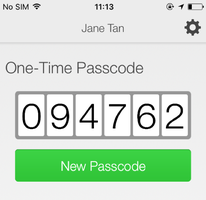
The OTP refreshes each time you open the PingID app. To generate a new OTP, tap New Passcode.
-
Enter the OTP into the text field. Click Sign In.
Result
After you have successfully authenticated, you are signed on to your VPN.
Authenticating manually (VPN)
When you sign on to your VPN, you might be asked to authenticate manually using the PingID mobile app.
Before you begin
To authenticate manually you need the following:
A device with the PingID mobile app 1.8 or later that is already paired with your account and with which you have successfully authenticated at least once.
About this task
You will not be asked to authenticate manually often, but be aware that authenticating manually is different than the normal sign on process.
Steps
-
Sign on to your VPN.

Result:
A Manual Authentication message appears, displaying a 12-digit key, and requests that you authenticate manually.
-
From your mobile device, open the PingID mobile app.
-
Tap the Gear icon (
 ) and select Manual Auth. Authenticate with your device biometrics, if required.
) and select Manual Auth. Authenticate with your device biometrics, if required.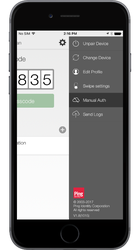
Result:
The Manual Authentication screen opens.

-
Tap Enter Key.
-
In the Security Key field, enter the 12-digit key displayed on the VPN sign on page, and tap Verify.
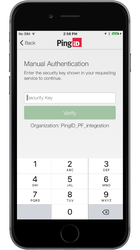
Result:
You receive an authentication code.
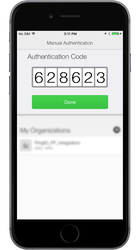
-
In the VPN Response field, enter the Authentication Code. Click Sign In.
Result:
You are successfully authenticated and signed on to your VPN.